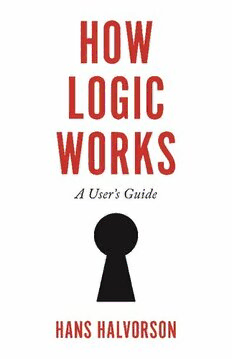
How logic works : a user's guide PDF
Preview How logic works : a user's guide
525-85030_ch01_6P — 2020/5/22 — 15:29 — page i — #1 How Logic Works 525-85030_ch01_6P — 2020/5/22 — 15:29 — page ii — #2 525-85030_ch01_6P — 2020/5/22 — 15:29 — page iii — #3 How Logic Works A User’s Guide Hans Halvorson PRINCETON UNIVERSITY PRESS PRINCETON & OXFORD 525-85030_ch01_6P — 2020/5/22 — 15:29 — page iv — #4 Copyright©2020byPrincetonUniversityPress Requestsforpermissiontoreproducematerialfromthiswork [email protected] PublishedbyPrincetonUniversityPress 41WilliamStreet,Princeton,NewJersey08540 IntheUnitedKingdom:PrincetonUniversityPress 6OxfordStreet,Woodstock,Oxfordshire,OX201TR AllRightsReserved ISBN9780691182223 ISBN(e-book)9780691208718 BritishLibraryCataloging-in-PublicationDataisavailable Editorial:MattRohal JacketDesign:LaylaMacRory Production:DanielleAmatucci Jacketimages:KeyholebyMariaSolomakhina; keybyGraphikDesignz,IN/TheNounProject ThisbookhasbeencomposedinLATEX Printedonacid-freepaper.∞ press.princeton.edu PrintedintheUnitedStatesofAmerica 1 3 5 7 9 10 8 6 4 2 525-85030_ch01_6P — 2020/5/22 — 15:29 — page v — #5 Contents preface vii 1 LogicforHumans 1 2 Deducing 8 3 Supposing 25 4 NewProofsfromOld 51 5 Truth 64 6 Quantifying 84 7 Theories 116 8 Models 156 9 ATheoryaboutPropositionalLogic 176 10 ATheoryaboutPredicateLogic 206 11 BeyondLogic 225 resumé of inference rules 231 useful valid argument forms 233 truth tables 235 validity tests for predicate logic 237 glossary 239 acronyms 243 index 245 v 525-85030_ch01_6P — 2020/5/22 — 15:29 — page vi — #6 525-85030_ch01_6P — 2020/5/22 — 15:29 — page vii — #7 Preface This book has no subject matter—or, to be more precise, it’s aboutbotheverythingandnothing. Forthescienceoflogichasnodoc- trines or creeds. There is no set of beliefs that distinguishes the logical peoplefromthenonlogicalpeople,notthebeliefsoftheEuropeanEnlight- enment, nor the deliverances of contemporary natural science, nor the opinionsofsomePrincetonphilosopher.Simplyput,learningthescience oflogiccan’tbereducedtolearninganyparticularfactsatall;it’slearninga skill,namely,theskilltodiscernbetweengoodandbadarguments. Therearenumerousreasonswhyyouneedthisskill, nomatterwhat you end up doing with your life. First, being logical will help you rea- sonabouthowtogetwhatyouwant.Second,manyofoursociety’sbest jobsrequirestronglogicskills—whether itbeprogrammingcomputers, buyingstockoptions,curingdiseases,prosecutingcriminals,discovering alternativeenergysources,orinterpretingtheConstitution.(Andthat’snot eventospeakofthatall-importanttaskofparentingandraisingintellectu- allyhealthychildren.)Third,regardlessofyourideologicalbent—whether you’rereligious,atheist,oragnostic—yousurelywanttodoeverythingyou cantoensurethatyourviewalignswithreality. Forthistask, logicisan invaluabletool,ifonlytoprotectyoufromtheplethoraofbadarguments you’llhearinyourlife. vii 525-85030_ch01_6P — 2020/5/22 — 15:29 — page viii — #8 viii Preface Ourgoalhereisnomoreorlessthantoinitiateyouintothemostup- to-dateaccountofwhatmakesanargumentgood.We’llgiveyouthetools, butit’suptoyoutodecidehowyou’regoingtousethem. Note about how to use this book: The first six chapters of this book (up through“Quantifying”)correspondroughlytoafirstcourseinformallogic at an average university in the United States. We cover the material in about a quarter of the number of pages of some well-known logic text- books,whichwasintentional:logicshouldorganizeyouralreadyexisting thoughts,notaddtothejumbleofthoughtsthatneedtobeorganized. Inchapter7,wegentlyrampuptoapplicationsofformallogic,andin particulartotheapplicationofformallogictothestudyofitself(i.e.,logical metatheory).Inonesense,thismaterialgoesbeyondatypicalfirstcourse inlogic,butwewouldliketochangethat.Thismaterialisnotintrinsically moredifficultthanwhathasgonebefore. Infact, whatcanmakeitseem difficultisthatit’slessclearwhatrulesofreasoningoneispermittedtouse. However,wetrytoexplainclearlythattherulesofreasoningherearenone otherthanthosethatwerelearnedinthepreviouschapters. Havingshownhowformallogiccanbeusedtoformulatetheories,we thenbegintouseformallogictoformulateatheoryaboutitself.Inchapter 8,weusethetheoryofsetstodefinethenotionofaninterpretationofa languageandTarski’srigorousdefinitionoftruth.Inchapter9,wepresent atheoryaboutpropositionallogic,provingbothsoundnessandcomplete- nesstheorems. Finally, inchapter10, wesketchtheoutlinesofasimilar theoryaboutquantifierlogic.Thus,thechaptersformanaturalstaircase leadinguptothetreasurechestofadvancedapplicationsoflogic,including modallogic,settheory,andGödel’stheorem. Notetotheinstructor, ortothepersondecidingwhichlogicbooktouse: To expressathought,ortomakeanargument,ortoformulateatheory,you havetopickalanguagetouse.Similarly,tobecomemorelogical,youhave toadoptsomeparticularsystemoflogic.I’vemadeachoiceforyouhere, andhereismyrationale. Thefirstchoicepointisbetween“trees”and“arguments.”Theadvan- tageoftreesisthattheyarereallyeasyandrequirelittlementalexertion. 525-85030_ch01_6P — 2020/5/22 — 15:29 — page ix — #9 Preface ix Butwait,isn’tthegoaltobecomethemostexcellentlogicalthinkersthat wecanbe?Peopledon’tbecomebetterlogicalthinkersbybeingtaughta recipethatsomebodyelsefoundandthatletsthemeffectivelyturntheir mindsoff.Butthat’spreciselythepointoflogicaltrees:theygivestudents arecipeforevaluatingsimplearguments.Ifthegoalweretomanufacturean armyoflogicalautomata,thenImightwellusetrees.ButsinceI’mteaching humanbeings,Iprefertoteachthemthatdistinctivelyhumanskillofmak- ingandevaluatingarguments.Accordingly,thisbookfocusesprimarilyon howtomakerigorousargumentsandsecondarilyonthe(nonalgorithmic) skillofdetectingbadarguments. The second choice point is whether to represent arguments using a “Fitch-style”ora“Lemmon-style”system.Thisisadifficultdecision.Fitch styleisveryintuitiveandhasashallowlearningcurve.Unfortunately,Fitch- styleargumentisopaquetoreflection:it’sdifficultforstudentstoseewhy Fitchstyleworksandevenmoredifficultforthemtoimaginehowtherules mighthavebeendifferent(therebyreinforcinganunfortunateperception thatthereisnohumancreativityinvolvedinformulatingthelawsoflogic). Incontrast,Lemmon-styleargumenthasasteeperlearningcurve,butit’s moreflexibleandtransparenttoreflection. It’srelativelyeasytoseewhy thesystemworks,andit’seasytotweaktherulesandseehowthingswould comeoutdifferent.So,thesteeperlearningcurveoftheLemmonapproach isapriceI’mwillingtopaytoenablemyreadertobecomeamoreclearand creativelogicalthinker. Thereareatleastfourwaysinwhichthisbookdiffersfrommanyother introductorylogicbooks. First, weteachintrinsicmethods(e.g.,reason- ing)priortoteachingextrinsicmethods(e.g.,checkingwithtruthtables). Here, our philosophical convictions have been reinforced by our peda- gogical experience, namely, that an argument-centric approach leads to studentsgainingahigherlevelofmasteryandconfidenceandthattheskills gainedaremoreeasilytransferabletootherintellectualtasks. Second, andforsimilarreasons, wetreatformalvalidityasdefinedin termsoftheinferencerulesandnotintermsoftruthpreservation. Our issuehereisthataprecisenotionoftruthpreservationrequiresaprevious understandingofvalidreasoninginsettheory.So,wewanttobeforthright withourreaderthatwe,atleast,don’thaveaclearanddistinctperception
